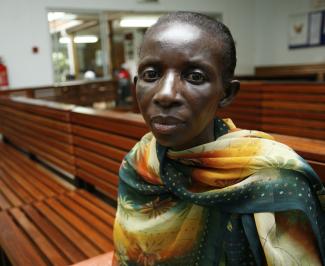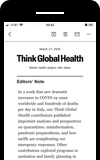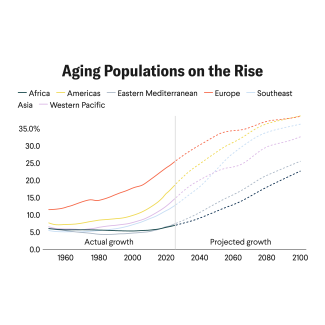One Thursday this April, I picked my way across the muddy courtyard of a clinic in the Majengo neighborhood of Moshi, Tanzania. The storm clouds cloaking Mount Kilimanjaro made the indoor spaces dusky, but there was no dimming the energy of the seven young people gathered there, flopping in chairs, cracking inside jokes, and fiddling with each other's pens and cups with familiar affection. These HIV-positive youth lead groups for adolescents to help cope with the turmoil of coming of age with a chronic illness. They were skilled beyond their years at using humor to diffuse discussions of their mortal fears.
Speaking in Swahili, the youth triggered gales of laughter in one another with statements that, when translated, hardly sounded humorous. "It's funny but painful," the translator said to me apologetically before explaining why a young woman with blonde-tipped braids made everyone chuckle. "The only fear she has is to die a shameful death. Especially when your hair falls out or any other thing that shows you have HIV. But otherwise, she is taking her medication, she has enough stock. . . that's the only fear. The shameful death."
Another young man elicited gales of laughter with his confession that a future without antiretroviral therapy (ART) access would cost him the chance to start a family without risking onward transmission of the virus. "Okay, my girlfriend doesn't have a kid, and I don't have a kid. Are we just dying like that?" Later, three of the young people with children said how frightened they were of leaving orphans behind.
All the youth in Majengo, akin to the 20 or so people living with HIV I spoke with over the next three weeks in Tanzania and Uganda, still had access to antiretrovirals. Even though their fear and dread were horrifying, they were not grievously ill and no one in their families or communities had died. These voices are underrepresented in the American media coverage of the consequences of the Donald Trump administration's cuts to foreign aid that have, since January 2025, included a freeze on all foreign aid enacted via stop work orders, grant cancellations, and a gutting of the U.S. Agency for International Development (USAID) that initially left just 17% of its grants in force.
In a completely understandable effort to demonstrate the impact, many stories focus on people with HIV who are severely ill or have died in the past five months. But a disproportionate focus on instances of death and severe disease related to cuts to the President's Emergency Plan for AIDS Relief (PEPFAR) could backfire and imperil the living.
What's Still Standing? PEPFAR Drug Supplies v. Support Programs
A predominant and misleading narrative is that the collapse of USAID has caused a proportional collapse in provision of antiretrovirals. During my trip, I spoke with clinicians and clients linked to at least 17 ART treatment clinics. All but one of those clinics still had antiretroviral drugs on its shelves.
What I saw and heard is not an anomaly. PEPFAR, a 22-year-old disease-focused initiative widely viewed as one of the most successful American foreign aid initiatives of the twentieth century, received a limited reprieve in the form of a waiver allowing continuation of some activities, including lifesaving testing and ART for people living with HIV. Some USAID grants remained active or were restored after cancellation. In many other clinics, though, USAID was not providing ART at all.
PEPFAR's remarkable success stems from its successful deployment of a "whole of government" response that harnesses the capacity of multiple agencies, including the U.S. Centers for Disease Control and Prevention (CDC). During PEPFAR's last fiscal year, which ended in October, CDC supported 61% of all people living with HIV on antiretrovirals and 59% of all new initiations on treatment and received just over 40% of PEPFAR's total budget.
Country governments also make major contributions to HIV programs, providing staff, space, salaries, and supplies. In places where USAID was supporting such efforts, the wait times have lengthened, the staff are exhausted, and stigma is often heightened for people such as sex workers and men who have sex with men. The drugs were still there, though, for those who could endure the new conditions.
This state of affairs is not good news. It is merely a qualitatively different calamity from the one most often described in American media coverage of PEPFAR. Conflating PEPFAR with USAID implies that the program has been bulldozed along with the agency when in fact PEPFAR is still standing, albeit with dangerous cracks in its foundation. It urgently needs to be repaired. The State Department's Bureau of Global Health Security and Diplomacy, which oversees PEPFAR, should work with country teams to ensure that every single activity covered under the waiver in every PEPFAR-funded country is up and running. For activities that are not, an agency other than USAID, such as CDC, should be tasked to step in immediately. The July 1 date for reconstituting USAID within the State Department is too far away.
Tragically and fatally, fixes for PEPFAR will not work for many crucial humanitarian programs providing food, immunizations, malaria medications, and so much more that were exclusively run by USAID. But focusing criticism of the USAID overhaul on the number of deaths to date could be counterproductive. Most of the 20.6 million people supported by PEPFAR on treatment are still alive. Deaths due to advanced HIV disease will be what epidemiologists call "a lagging indicator" that climbs up years after the inciting event.
That CDC supported clinics are still operating and that some USAID-funded treatment activities have been picked up by other agencies means that the morgues and wards will not fill overnight. A more nuanced, no less anguished call to action by members of Congress and advocates is needed before skeptics have evidence to suggest that predictions of mass death were exaggerated.
I heard that call across my conversations in East Africa. Nearly everyone I spoke with during my reporting described a level of dread that was painful to behold. But every conversation also revealed clues about how to assuage these concerns and stabilize the HIV response before some of the worst fears are realized.
The Lives of HIV Peer Navigators and Counselors
Many Ugandans and Tanzanians said they are terrified because their governments have not explained what to expect clearly and in writing. The young Tanzanian man who worried that he wouldn't have children was tormented by the fear that he was misleading clients who asked whether the drugs would continue to be on the shelves. He reassured them that the stocks would remain. "What if it happens in three months the medication won't be there and yet I gave hope to this person? How will I be seen? What I was told is just the little information that I have but we don't know a lot more that is coming."
Longtime HIV activists also worry that governments are moving quickly to dispense with the community-led services, such as drug distribution points and peer educators, that have helped people living on the margins of society stay healthy and live with dignity.
The United States is not and should not be the leading voice defining the future in these respective countries, and American media coverage could benefit from balancing stories about what has been lost with America's pullback with explanations about what remains in terms of the country's leadership and community systems. Based on what I heard, country governments can do more to work with affected communities to devise acute and chronic plans for stabilizing programs. The United States and other donor countries have a role to play in steadfastly stating the evidence that community-led services deliver impact.
In recent U.S. agenda for PEPFAR's future released by Center for Strategic and International Studies, community-led activities did not make the list of "essential elements" for a five-year transition. It could be hugely beneficial for such agendas to amplify and affirm people living with HIV and their calls to preserve the workforce and service delivery models that helped bring so many countries to the brink of controlling HIV as a public health threat.
Some of the strongest evidence relates to the consequences for cadres of health workers like the young people in Majengo, who provide critical care to people whose circumstances complicates trips to the clinic to take pills—even when the drugs are well stocked. I spoke with more than a half dozen peer navigators and counselors who recounted their stories of receiving the stop work orders via text message or email with a disbelief and urgency that reminded me of New Yorkers after 9/11.
Angel had been packing medications for community-based distribution the following day. Pendo was online with a client waiting to receive test results. Benedict was with a client who'd just started antiretrovirals and developed a terrible rash. In an instant they'd lost their jobs and their ability to help their clients survive.
Angel, Pendo, and Benedict told me they made $75 per month. Without that salary, they'd lost almost everything. Pendo's bright daughter could not go to the secondary school she'd tested into. Benedict had sold his mattress, bedframe, and kitchen appliances to pay rent; he got calls from former clients all the time, including the brother of the patient with the rash, reporting that he was now refusing to take the drugs. Angel often didn't have diapers for her 5-month-old daughter. She had called all the clients expecting a drug delivery to their communities and told them to come to the clinic instead. Three months later, she didn't think all of them had gone to pick up their medication.
The thousands of peer navigators and counselors told to walk away from their clients and communities in late January require and deserve innovative attention and action. Some, like a transgender woman in Tanzania, face physical risks in the wake of the U.S. withdrawal of aid programs that closely resemble the perils of the U.S. Army's Afghan translators being left behind in August 2021. Groups such as No One Left Behind could lend their expertise and moral clarity to ensure protections for the low-paid frontline workers behind successful U.S. programs.
This workforce is part of an essential community-based response that planted roots years before ART was freely available in sub-Saharan Africa. In 2000, I sat with Ugandan people living with HIV as they rationed scant courses of donated antiretrovirals, deciding who among them was most worthy and most necessary for the activist cause. They not only allocated the medications, they made sure that their friends got to the clinic, managed side effects, remembered to take what was, at that time, a handful of pills. People who lived through those times are haunted today. People, like the youth in Majengo, who were born into a world where drugs were there when needed, have no problem imagining what it will be like if those times return.
The darkest days have not come back yet—and they need not. The U.S. State Department should publicly commit to ensuring that every single waiver-covered activity in every PEPFAR country is up and running by the end of the month, either through rescindment of canceled USAID grants, or through shifts to implementation by other agencies. Programs that remain shuttered cannot, at this point, be blamed on the Department of Government Efficiency.
Governments and funders, including the Global Fund, which is about to execute a two-week "reprioritization" sprint to address a shortfall in available funds, should recognize that community-led services and workers are essential and act accordingly. Two-way communication with affected communities that addresses fears should be the norm. These steps will not heal the losses and harms already done, but they will avert a far more terrible future.
EDITOR'S NOTE: Only first names were used for peer navigators to protect their identities.


